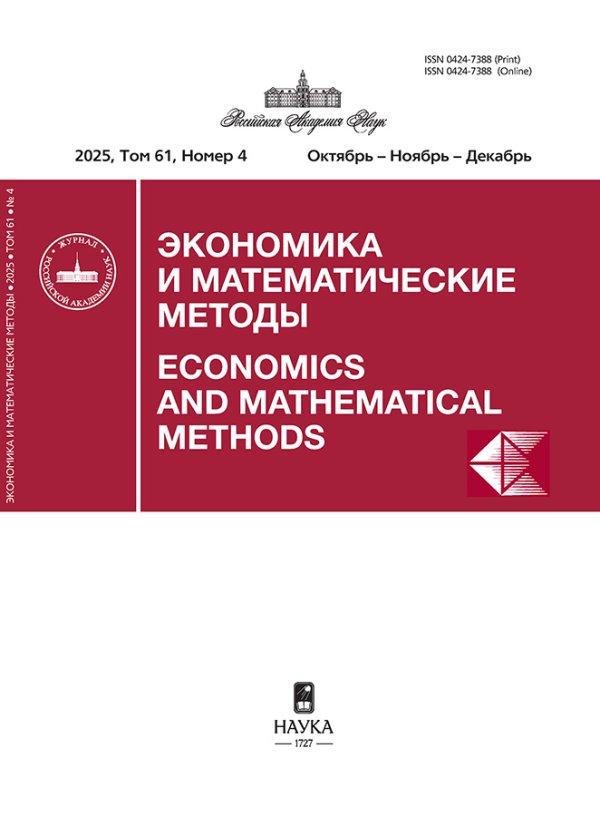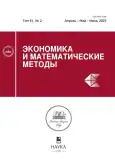Вейвлет-анализ взаимосвязи между ценами на энергоресурсы и индексами акций компаний с высокими ESG-рейтингами: возможности диверсификации инвестиций
- Авторы: Соколова Т.В.1, Гуров С.В.1, Медведев В.А.1, Лысенко В.В.1
-
Учреждения:
- НИУ «Высшая школа экономики»
- Выпуск: Том 61, № 2 (2025)
- Страницы: 128-142
- Раздел: Математический анализ экономических моделей
- URL: https://vestnik.nvsu.ru/0424-7388/article/view/684544
- DOI: https://doi.org/10.31857/S0424738825020108
- ID: 684544
Цитировать
Полный текст
Аннотация
Мы впервые выявляем взаимосвязи между ценами на нефть «Brent» и природный газ и индексами акций компаний с высокими ESG-рейтингами во временной и частотной областях. Мы применяем такие методы вейвлет-анализа, как анализ квадратичной вейвлет-когерентности и разности фаз между рядами данных. Исследование строится на ежедневных данных с 2018 по начало 2024 г., что позволяет охватить периоды относительной макроэкономической стабильности (до 2020 г.), пандемии коронавируса COVID-19 (2020–2021 г.) и роста геополитической напряженности в мире (с 2022 г.). Мы рассматриваем ESG-индексы глобального рынка, рынков США и ЕС. В нашем исследовании показаны области низкой и высокой согласованности цен на энергоресурсы и ESG-ориентированных индексов для трех рассматриваемых периодов, выявлены соотношения запаздывания и опережения между рассматриваемыми классами активов. Выявление областей низкой согласованности позволяет разработать стратегии диверсификации инвестиций, в том числе для хеджирования от падений цен на нефть и газ в условиях глобальных кризисов. Мы пришли к выводу, что индексы акций компаний–лидеров ESG глобального рынка и рынка США предоставляют возможности для диверсификации инвестиций во фьючерсы на природный газ.
Полный текст
Об авторах
Т. В. Соколова
НИУ «Высшая школа экономики»
Автор, ответственный за переписку.
Email: tv.sokolova@hse.ru
Россия, Москва
С. В. Гуров
НИУ «Высшая школа экономики»
Email: sgurov@hse.ru
Россия, Москва
В. А. Медведев
НИУ «Высшая школа экономики»
Email: medvedev.v@hse.ru
Россия, Москва
В. В. Лысенко
НИУ «Высшая школа экономики»
Email: vlysenko@hse.ru
Россия, Москва
Список литературы
- Aguiar-Conraria L., Azevedo N., Soares M. J. (2008). Using wavelets to decompose the time–frequency effects of monetary policy. Physica A: Statistical Mechanics and Its Applications, 387, 12, 2863–2878.
- Albuquerque R., Koskinen Y., Yang S., Zhang C. (2020). Resiliency of environmental and social stocks: An analysis of the exogenous COVID-19 market crash. The Review of Corporate Finance Studies, 9, 593–621.
- Alnafrah I. (2024). ESG practices mitigating geopolitical risks: Implications for sustainable environmental management. Journal of Environmental Management, 358, Article 120923.
- Ameur H. B., Jawadi F., Jawadi N., Cheffou A. I. (2020). Assessing downside and upside risk spillovers across conventional and socially responsible stock markets. Economic Modelling, 88, 200–210.
- Andersson E., Hoque M., Rahman M. L., Uddin G. S., Jayasekera R. (2022). ESG investment: What do we learn from its interaction with stock, currency and commodity markets. International Journal of Finance and Economics, 27, 3623–3639.
- Balcilar M., Gabauer D., Umar Z. (2020). Crude oil futures contracts and commodity markets: New evidence from a TVP-VAR extended joint connectedness approach. Resources Policy, 73, 102219.
- Bhattacherjee P., Mishra S., Kang S. H. (2023). Does market sentiment and global uncertainties influence ESG-oil nexus? A time-frequency analysis. Part. A. Resources Policy, 86, 104130.
- Bossman A., Gubareva M., Teplova T. (2023). Economic policy uncertainty, geopolitical risk, market sentiment, and regional stocks: Asymmetric analyses of the EU sectors. Eurasian Economic Review, 13, 321–372.
- Broadstock D. C., Chan K., Cheng L. T.W., Wang X. (2021). The role of ESG performance during times of financial crisis: Evidence from COVID-19 in China. Finance Research Letters, 38, 101716.
- Cagli E. C.C., Mandaci P. E., Taşkın D. (2023). Environmental, social, and governance (ESG) investing and commodities: Dynamic connectedness and risk management strategies. Sustainability Accounting, Management and Policy Journal, 14, 5, 1052–1074.
- Chen Y., Wei Y., Bai L., Zhang J. (2023). Can Green economy stocks hedge natural gas market risk? Evidence during Russia-Ukraine conflict and other crisis periods. Finance Research Letters, 53, 103632.
- Ferrer R., Benítez R., Bolós V. J. (2021). Interdependence between green financial instruments and major conventional assets: A wavelet-based network analysis. Mathematics, 9, 8, 900.
- Frikha W., Béjaoui A., Bariviera A. F., Jeribi A. (2024). What matters for co-movements among gold, Bitcoin, CO2, commodities, VIX and international stock markets during the health, political and bank crises. Risks, 12, 3, 47.
- Gubareva M., Umar Z., Sokolova T., Antonyuk V. (2023). For whom does it pay to be a moral capitalist? Sustainability of corporate financial performance of ESG investment. PLoS ONE, 18, 5, e0285027.
- Jain M., Gagan D. S., Srivastava М. (2019). Can sustainable investment yield better financial returns: A comparative study of ESG indices and MSCI indices. Risks, 7, 1, 15.
- Jiang Y., Wang J., Lie J., Mo B. (2021). Dynamic dependence nexus and causality of the renewable energy stock markets on the fossil energy markets. Energy, 233, 121191.
- Li J., Li G., Zhu X., Yao Y. (2020). Identifying the influential factors of commodity futures prices through a new text mining approach. Quantitative Finance, 20, 12, 1967–1981.
- Liu H., Pata U. K., Zafar M. W., Kartal M. T., Karlilar S., Caglar A. E. (2023). Do oil and natural gas prices affect carbon efficiency? Daily evidence from China by wavelet transform-based approaches. Part B. Resources Policy, 85, 104039.
- Liu T., Hamori S. (2020). Spillovers to renewable energy stocks in the US and Europe: Are they different. Energies, 13, 12, 3162.
- Liu T., Nakajima T., Hamori S., (2021). Which factors will affect the ESG index in the USA and Europe: Stock, crude oil, or gold. In: ESG Investment in the Global Economy. Springer Briefs in Economics. In: ESG Investment in the Global Economy. Chapter 4, 53–70. doi: 10.1007/978-981-16-2990-7
- Magazzino C., Giolli L. (2024). Analyzing the relationship between oil prices and renewable energy sources in Italy during the first COVID-19 wave through quantile and wavelet analyses. Renewable Energy Focus, 48, 100544.
- Magazzino C., Shahbaz M., Adamo M. (2023). On the relationship between oil market and European stock returns. Environmental Science and Pollution Research, 30, 123452–123465.
- Marín-Rodríguez N.J., González-Ruiz J.D., Botero S. (2022). Dynamic relationships among green bonds, CO2 emissions, and oil prices. Frontiers in Environmental Sciences, 10, 992726.
- Melek N. C. (2018). The response of U.S. investment to oil price shocks: Does the shale boom matter. Economic Review, 103, 4, 39–61.
- Mensi W., Al-Yahyaee K.H., Vo X. V., Kang S. H. (2021). Dynamic spillover and connectedness between oil futures and European bonds. The North American Journal of Economics and Finance, 56, 101342.
- Omri A., Daly S., Nguyen D. K. (2015). A robust analysis of the relationship between renewable energy consumption and its main drivers. Applied Economics, 47, 2913–2923.
- Pedini L., Severini S. (2022). Exploring the hedge, diversifier and safe haven properties of ESG investments: A cross-quantilogram analysis. Munich Personal RePEc Archive Paper, 112339. Available at: https://mpra.ub.uni-muenchen.de/112339/
- Piserà S., Chiappini H. (2024). Are ESG indexes a safe-haven or hedging asset? Evidence from the COVID-19 pandemic in China. International Journal of Emerging Markets, 19, 1, 56–75.
- Teplova T., Sokolova T., Kissa D. (2023). Revealing stock liquidity determinants by means of explainable AI: The role of ESG before and during the COVID-19 pandemic. Part B. Resources Policy, 86, 104253.
- Torrence C., Compo G. P. (1998). A practical guide to wavelet analysis. Bulletin of the American Meteorological Society, 79, 61–78.
- Torrence C., Webster P. J. (1999). Interdecadal changes in the ENSO–Monsoon system. Journal of Climate, 12, 2679–2690.
- Umar Z., Gubareva M., Teplova T., Tran D. K. (2022). Covid-19 impact on NFTs and major asset classes interrelations: Insights from the wavelet coherence analysis. Finance Research Letters, 47 B, 102725.
- Yahya M., Kanjilal K., Dutta A., Uddin G. S., Ghosh S. (2023). Can clean energy stock price rule oil price? New evidences from a regime-switching model at first and second moments. Energy Economics, 95, 105116.
- Yu H. (2022). Does sustainable competitive advantage make a difference in stock performance during the Covid-19 pandemic. Finance Research Letters, 48, 102893.
- Zaremba A., Umar Z., Mikutowski M. (2019). Inflation hedging with commodities: A wavelet analysis of seven centuries worth of data. Economics Letters, 181, 90–94.
Дополнительные файлы
















